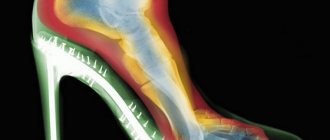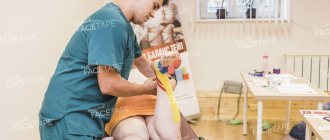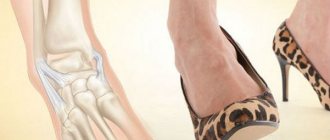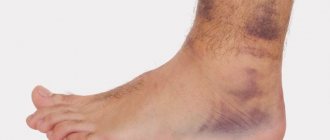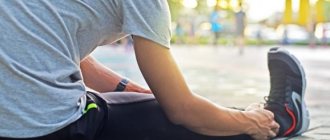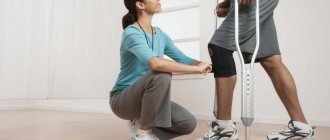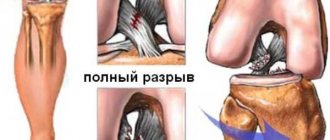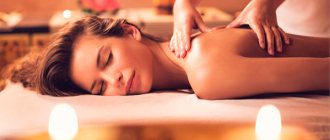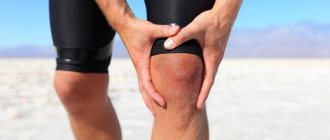Injuries to the musculoskeletal system are a very common occurrence, not only among athletes, but also in everyday life. The most common of them is soft tissue bruise. In most cases, bruises are low-risk and heal quite well, but they are almost always accompanied by muscle damage and rupture of blood vessels, which leads to the formation of hematomas. As a result, bruises can be very painful and are accompanied by dysfunction of one or another part of the body.
Therapeutic massage performed for such injuries helps reduce pain, accelerate the resorption of hematomas, improve tissue healing and eliminate swelling.
Preparatory and main massage
Massage helps improve blood circulation, affects muscle contractility, relieves pain, normalizes metabolic processes, prevents atrophic processes in muscles, and relieves swelling. In the case of sports massage, all standard techniques are used: stroking, rubbing, kneading, squeezing.
Before starting the procedures, the patient must be completely relaxed. If he has serious damage to the musculoskeletal system, then a preparatory massage is recommended, and then the main one. In any case, massage for sports injuries is carried out only after consultation with a doctor.
Preliminary massage is done on parts of the body that are not affected by injury. It will take several sessions for the effect to appear. The massage therapist's movements should be smooth and not cause pain to the patient, mainly stroking, light squeezing or shaking. Sessions are short, no more than 7 minutes, but are held two or three times a day.
After a couple of days, you can begin the main course of massage. It will be carried out in the area of injury. It is important to pay attention to the following facts: the athlete should not experience severe discomfort when massaging this area, the swelling should go away and there should be no fever. The full range of massage techniques is used, but without causing pain
. To quickly restore damaged tissue, you can use medicinal ointments: myositis or myalgin - if the muscles or peripheral nervous system are damaged, and amirzartron or vipratox - if bruises and sprains are diagnosed.
Massage for sports injuries can be combined with physiotherapy and therapeutic exercises.
Read also[edit | edit code]
- Anatomy of the knee joint
- Knee injury
- Sports knee injury - treatment
- Massage for bruises
- Massage after surgical treatment of habitual shoulder dislocation
- Massage for bone fractures
- Massage for hand and foot injuries
- Massage for a spinal fracture
- Massage for a broken collarbone
- Massage for a fractured scapula
- Massage for pelvic fractures
- Massage for Achilles tendon rupture
- Massage for damaged menisci of the knee joint
Massage for sprains
Most often, sprains are diagnosed in the upper or lower extremities. With such an injury, the synovial membranes and tendons can be damaged. The pathology is associated with swelling, severe pain and loss of mobility. Already on the second day you can prescribe thermal procedures
, after them it is recommended to do a massage. In the case when there is no pain in the joint, it is allowed to knead it.
It is best to place the injured arm behind your back and simultaneously work on both the right and left joints. The shoulder joints should be massaged while lying on a table to achieve maximum relaxation. A pillow is placed under the knee or ankle joint.
Symptoms of a sprain
- Sharp, nagging pain. Persists for a long time after injury
- Swelling
- If the stretch is significant, some tissue may be torn. A hematoma appears at the site of impact
- Inability to move the affected joint
- Sometimes there is a cramp in the damaged muscles
- If a large muscle rupture occurs, a ball can be felt under the skin. These are torn fibers collected in a lump.
Commentary from a traumatologist-orthopedist
Sprains of ligaments and muscles have similar symptoms, but they can be distinguished by the time of onset of pain: with a sprain, pain appears immediately or within a short time after the injury, and in the case of muscles, the interval can be up to a day.
Butkevich Anton Andreevich
Massage for fractures
A fracture is a break in the integrity of one or more bones. It can be complete or partial, closed or open. In this case, massage can improve blood circulation, increase muscle elasticity, and restore the functionality of the injured part of the body in the shortest possible time.
It is worth noting that massage is contraindicated for open fractures.
and it can only be used for closed fractures. In the second case, massage is prescribed two or three days after the injury. The main task of the specialist is to relieve increased muscle tone.
Degrees
There are three degrees of severity of a sprain:
- Grade I - slight pain due to rupture of several fibers of the ligament.
- Grade II - moderate pain, swelling and disability.
- Grade III - severe pain due to ligament rupture and subsequent instability of the joint.
A muscle strain, in turn, is a traumatic injury to the muscle fibers themselves or the connection between muscle and tendon, and is also classified into three degrees of severity:
- I - moderate.
- II - moderate degree of damage, associated with weakness of the affected muscle, its painful contraction.
- III - complete rupture of the connection between muscle and tendon, manifested by severe pain and the inability to contract the damaged muscle.
Recommendations for improving the effect after massage
Ideally, after the session you can come home and rest for 30-40 minutes, relax. You can take a warm bath with sea salt or natural essential oils. It is also recommended to increase the amount of fluid consumed and eat right.
Diagnostics before the first massage session is a mandatory procedure. It is performed with the goal of not harming and helping the patient.
Extracts from the medical record, photographs and doctor’s reports, and a referral for a massage do not replace the examination of the patient by the massage therapist himself.
If there are any doubts on the part of the massage therapist, before the session, the specialist can invite a doctor to the office for consultation, who is always available in our clinic. An additional completely free consultation with a doctor is a concern for your health and an indicator of our responsible attitude.
Remember: a specialist at our clinic has the right to refuse you a massage session if he considers that the procedure may harm you.
Using various techniques, massage therapists help the patient get rid of various health problems. These include: dysfunction of the cardiovascular system, joint diseases, muscle dysfunction, consequences of fractures, obesity and much more.
In some cases, one massage is enough to combat the disease, but often massage is an integral part of general medical therapy.
Self-massage for bruises, sprains, dislocations
The effect of self-massage in all cases of joint damage leads to:
- skin hyperemia (redness of the skin);
- activation of muscle contractions;
- reducing the overall pain of the injured limb;
- improving metabolism;
- preventing atrophy and eliminating existing muscle atrophy;
- accelerated resorption of effusions, swelling, infiltrates and hemorrhages.
Self-massage for bruises, sprains, dislocations , especially early sessions, helps reduce pain and quickly restore joint function.
A.P. Zelenkov, a famous Russian physician-physiologist, noted back in 1889 that anyone who wants to restore normal mobility of a joint after it has already lost it is like a sculptor who would like to model clay after it hardened. At the cost of incredible efforts and loss of time, he will achieve what he could previously achieve jokingly.
Initially, self-massage is applied above the site of a bruise, fracture, etc. For example, when the ligamentous system of the ankle joint is sprained, the lower leg is massaged, when the knee joint is damaged, the thigh is massaged, when the wrist joint is damaged, the forearm is massaged, when the elbow joint is damaged, the shoulder is massaged, etc. Suction massage is done twice a day for 4-7 minutes. Gradually the duration of the sessions increases to 10-12 minutes. Apply stroking, squeezing, kneading.
After two to three days (4-6 sessions) they begin to massage the injured area directly. First, massage the overlying area, and then move to the sore spot. They start with stroking and light rubbing and gradually move on to a deeper massage, using weighted rubbing, straight and circular. Self-massage is alternated with active and passive movements. It is also recommended to combine self-massage with thermal procedures (warm water bath, dry air bath, Sollux, paraffin). The bath gives very good results.
At home, various warming substances are often used in the form of rubs and ointments, which contribute to the rapid and better restoration of functions of joints and ligaments in case of dislocations, sprains, bruises, as well as rheumatic diseases of the joints (arthritis, arthrosis), myalgia, neuralgia, neuritis, radiculitis, sciatica and for injuries, as well as warming one or another part of the body (lower back, joints, intercostal spaces, etc.). However, before choosing rubs and ointments, you need to consult your doctor.
If you are prescribed ointments such as Viprosal, Apizartron, Virapin, Vipratox, Vascularin, Nicoflex, Efkamon, Tiger, you should first test skin sensitivity. To do this, squeeze out half a centimeter of ointment from the tube and apply it to the skin to check the reaction. If the ointment is easily tolerated by the skin, apply 3-4 cm (a teaspoon) of ointment to the sore spot (or a place that needs to be quickly warmed up). When a feeling of warmth (burning) appears, the ointment is rubbed in. If the sore spot is too sensitive and pain occurs, you can massage it above or below it: the medicinal components contained in the ointments will be delivered through the blood vessels to the sore spot.
For the first time, it is best to apply ointments in the evening, before bed. On the second day, if the first session was well tolerated, the same dose is applied three times a day: in the morning, in the afternoon and in the evening before bed. On the third day - morning and evening, but the amount of ointment can be increased. After rubbing the ointment, the sore spot should be kept warm, wrapped in a warm cloth, preferably woolen. If there is a strong burning sensation in the area being massaged, you can lubricate it with Vaseline.
The most potent ointments are dolpic and finalgon, slonts. They should be used with extreme caution. To determine skin sensitivity, apply a minimal amount of ointment—about the size of a grain of rice—to the sore spot. If no discomfort occurs, the next day the amount of ointment can be increased 2-3 times, but not more. Then the sore spot is rubbed as described above. When massaging with dolpic and finalon, it is necessary to take into account that after rubbing them in, a film is formed on the skin, which during subsequent rubbings interferes with the therapeutic effect, therefore, before the next rubbing, you need to take a hot shower.
When using rubs, you need to make sure that the ointment does not get on the mucous membrane. After rubbing, wash your hands with warm water and soap.
For pain in the muscles, bruises, swelling, I advise you to use the ointment compiled by Professor I.M. Sarkizov-Serazini. The recipe for this ointment is as follows: 15.0 - ichthyol, 3.0 - potassium iodide, 0.25 - crystalline iodine, 0.2 - belladonna extract, 10.0 - camphor, 30.0 - petroleum jelly, 35.0 - anhydrous lanolin . The compress with this ointment is changed every day until the pain or swelling goes away.
Despite the rapid development of chemistry and the creation of new high-quality synthetic drugs, we must not forget about folk remedies, the healing effects of which have been scientifically proven. For lumbosacral radiculitis, muscle pain, bruises, sprains, for example, I recommend horseradish root gruel or a compress from it as a rubbing agent (hold for 20-30 minutes). Apply the grated horseradish to the gauze, in a layer of about 0.5 cm. Dip the gauze with the gruel into warm water and quickly pull it out. This will deprive the horseradish of its burning effect, after which you can apply a compress.
For inflammation of the joints, myositis, gout, and rheumatism, an infusion of birch buds in 90-degree alcohol (1:5) is often used. You can rub or compress with tincture after a 3-5 minute massage.
For various bruises, sprains, and gout, a compress of medicinal bovine bile helps. It can be left overnight.
For lumbosacral radiculitis, a compress made from sour dough gives a good effect. First you need to rub 15-20 g of turpentine into the sore spot. Keep the compress for no more than 40-50 minutes, do it daily for 4-6 days.
Different countries of the world and different peoples had and have their own traditional methods of treatment. In Rus', for example, they saved themselves from rheumatism by using a bathhouse, and then rubbing themselves with a tincture of herbs and roots.
In Egypt, back in the days of the pharaohs, there was a method of treating rheumatism using hot sand. Now it is being used again in the “mobile clinic” of a certain Abdel Motocelli, located near the famous pyramids. The patient is buried in hot sand. The session lasts 30 minutes. During this time, the patient's body produces so much sweat that the sand around it becomes wet. The patient is then dug out, wrapped in a thick, dry blanket and taken to a tent, where he is given a cup of hot broth to restore lost moisture. Then a massage is performed with an emphasis on the joints. Motocelli claims that after ten sessions there is no trace of rheumatism left.
I’m not sure about rheumatism, but as for pain in muscles and joints from walking or any other physical exercise, then after such a sand bath and a 20-25-minute massage, of course, they will go away as if by hand. And in our country, for pain in the joints after physical education, we often use heated sand or salt, after pouring it into a bag made of thick cotton fabric. Sandbags are applied to the joint for 20-25 minutes, i.e. until the sand cools down. After this, the joint is lubricated with cream and an 8-10-minute massage is performed.
To ensure a knee massage is effective and comfortable, adhere to the following rules:
- The massage therapist stands on the side of the leg being massaged;
- the patient lies on his back, legs slightly apart;
- a cushion is placed under the knees, the leg should be relaxed;
- movements are made along the blood flow of lymphatic and blood vessels - from the lower leg to the groin;
- The intensity of kneading is increased from session to session so that the muscles, ligaments and cartilage adapt to the load.
Massage is included in the complex of physiotherapy measures for arthrosis. However, it should only be performed by a specialist, since careless actions can damage the kneecap, ligaments and joint.
Massage after ankle ligament rupture
Severe ankle injuries require surgery or prolonged immobilization in a cast. Massage is not used during the acute period. But it is used during the recovery period to speed up the patient’s rehabilitation and reduce symptoms.
Various operations are performed, depending on the characteristics of the injury. After some, immobilization is required. Many reconstructive ligament surgeries do not involve the subsequent application of a cast. Therefore, from the first days, patients are allowed to load the limb and engage in physical exercise. In the first two to three weeks, it is loaded minimally, when walking with crutches. Subsequently, a cane is used as a support.
Massage can be performed from the first days after surgery. But it is not the joint itself that is massaged, but the soft tissue nearby. In the long-term rehabilitation period, massage is used to restore range of motion in the ankle joint.
Do you need diagnostics?
You should not start a massage right away. For ankle injuries, if the leg is swollen and painful, if a hematoma has appeared, and especially in situations where the patient cannot step on the leg or the joint has become unstable, a diagnosis is needed. You should consult a doctor and at least do an ultrasound of the joint or an x-ray (or even better, an MRI) to understand:
- the ligament is partially torn or completely torn;
- are there any concomitant inflammatory changes in adjacent ligaments;
- are there any intra-articular bone fractures?
Based on the results of the examination, the doctor will make a conclusion about the preferred method of treatment. You may need surgery or immobilization of the limb in a cast. In such a situation, the problem cannot be solved with massage alone. Although it can be used later - during the rehabilitation period.
When do you need a knee massage?
If in the case of the neck, shoulders, and back, massage is often done for preventive purposes, then in relation to the knee there are always medical indications:
- bruise – after falling or hitting an obstacle;
- sprain or rupture of ligaments - during sports, after a fall or accident;
- dislocation - a rare occurrence with the knee, due to accidents or serious injury;
- damage to the meniscus - internal or lateral (relevant for athletes and older people);
- intra-articular fracture - occurs in older people;
- cartilage damage - most often post-traumatic arthrosis develops after a dislocation, fracture or bruise.
Knee massage should be done by a specialist
What to look for when choosing a massage therapist
Incompetent massage therapists are a big problem in the medical world. Such specialists have harmed the health of many people. There are several signs that this is not a medical professional who is trying to help, but a person aimed solely at commercial gain.
You should be wary if the massage therapist:
- gives a 100% guarantee of complete recovery;
- says that there are no contraindications to massage;
- promises, using the author’s method, to remove all toxins and waste from the body in 3 sessions, get rid of 10 kg of excess weight with one touch, etc.;
- insists on replacing the treatment prescribed by the doctor with dietary supplements and other magic pills;
- names the exact duration of the course in absentia.
Remember that medical massage is a fairly serious physiotherapeutic procedure in which such negligence is unacceptable. Do not risk your health, contact a medical institution, and not dubious specialists.
Our Clinic has professionals with many years of experience and medical education. They are well versed in anatomy, neurology and other fields, which help them form a correct idea of what processes occur in your body. Your health is in good hands here.
How did massage appear and why was the attitude towards it controversial?
The word “massage” comes from the French language (masser - to rub). Moreover, the procedure itself was known even to primitive peoples. The first official evidence of massage techniques appeared in Ancient China, in the 3rd millennium BC. Even then, there were medical and physical education educational institutions, where one of the disciplines was massage.
During the Middle Ages, massage therapists were subjected to severe persecution. The Holy Inquisition was convinced that pain relief and healing through the touch of hands was a clear sign of the devil. Witch doctors were declared sorcerers and witches and burned at the stake. Only 300 years ago in Europe the works of scientists about massage and its healing properties began to appear again.
Fortunately, in our country there has never been a bias towards the procedure, and therefore the methodology has developed over many centuries. In Ancient Rus', massage was revered both as a full-fledged healing tool and as a pleasant element when going to the bathhouse (rubbing, patting with a broom). Nowadays, massage is recommended for the prevention and treatment of many diseases, and along with manual methods, modern hardware technologies are appearing.
A massage therapist in a clinic, a massage therapist in a beauty salon, a chiropractor: what’s the difference?
The massage therapist works on the patient's body with his hands, kneading, patting, stroking, rubbing, shaking, pressing, rolling and vibrating. Unlike a chiropractor, he does not have the right to prescribe treatment or realign joints and vertebrae.
A “manual specialist” is a doctor who graduated from a medical school, residency or internship in the specialty “neurologist” or “traumatologist-orthopedist”. In addition, such a doctor has additionally completed a specialized retraining program in manual therapy.
A massage therapist in a medical clinic is a specialist with a secondary medical education in the specialties “therapeutic physical education”, “medical massage”, “nursing”, “physical rehabilitation and recreation”, “massage nurse”. An option with retraining is possible, but only if you have a secondary medical education. Such a specialist has the right to conduct medical, sports, myofascial and other types of massage. Without confirmed qualifications, a person will not be able to perform such procedures and get a job in a clinic. If this norm is violated, then according to Article 69, Article 323 of the Federal Law, the person bears criminal liability.
A massage therapist in a beauty salon, as a rule, does not have a medical education and provides non-medical massage (cosmetological, relaxing). The theoretical and practical knowledge base of a specialist is limited to short-term courses (53-72 academic hours). In this case, the quality of services is practically not confirmed by anything other than the reputation of the salon.
Why massage the knee joint?
In a healthy person, manipulations such as squats, going up/down stairs and other movements that involve the legs do not cause any difficulties. If such actions cause discomfort or pain, the knees begin to “crunch”, the skin turns red and swells - this is the body’s signal about problems with the joints and the start of serious destructive processes. Diseases of this kind are quite dangerous, because they threaten the loss of motor activity.
The fight against arthritis, arthrosis, conditions after surgery, knee injuries or endoprosthetics involves a long (and sometimes permanent) process of taking medications, following a diet and knee-joint massage.
Proper massage of the knees at the primary stage of pathology, when the destruction of cartilage tissue is just beginning, has enormous success:
- activates blood supply;
- restores mobility functions;
- improves cell regeneration.
In advanced stages of disease, the procedure is no less important:
- pain syndrome decreases;
- joint destruction slows down;
- the motor process is facilitated.
Massage of the knee joint helps to recover faster after arthroscopy, especially if it was performed for diagnostic purposes.
Contraindications
Despite the obvious harmlessness of the procedure, there are a number of contraindications to its implementation. It is not recommended for patients suffering from acute inflammation caused by various types of chronic diseases. You should not resort to sessions at elevated body temperature with increased ESR levels in the blood, or if swelling with inflammation or extensive hemorrhages occurs. Other contraindications include thrombosis, bleeding, various skin diseases (dermatitis, rashes, etc.).
